Swimming with whale sharks provides a unique marine experience. These gentle giants can grow up to 61.7 feet long and feed on plankton and small fish.
They are found in warm, tropical waters, particularly in places like La Paz, Mexico, from October to February.
To ensure a safe and enjoyable experience, follow safety guidelines, such as maintaining a safe distance and using snorkeling gear. This not only enhances your interaction but also minimizes disruption to their natural behavior.
Interacting with whale sharks fosters appreciation for these majestic animals and highlights the importance of conservation efforts to protect their habitats and populations.
This interaction also reveals more fascinating insights to explore, encouraging further discovery and learning.
Overview of Whale Sharks
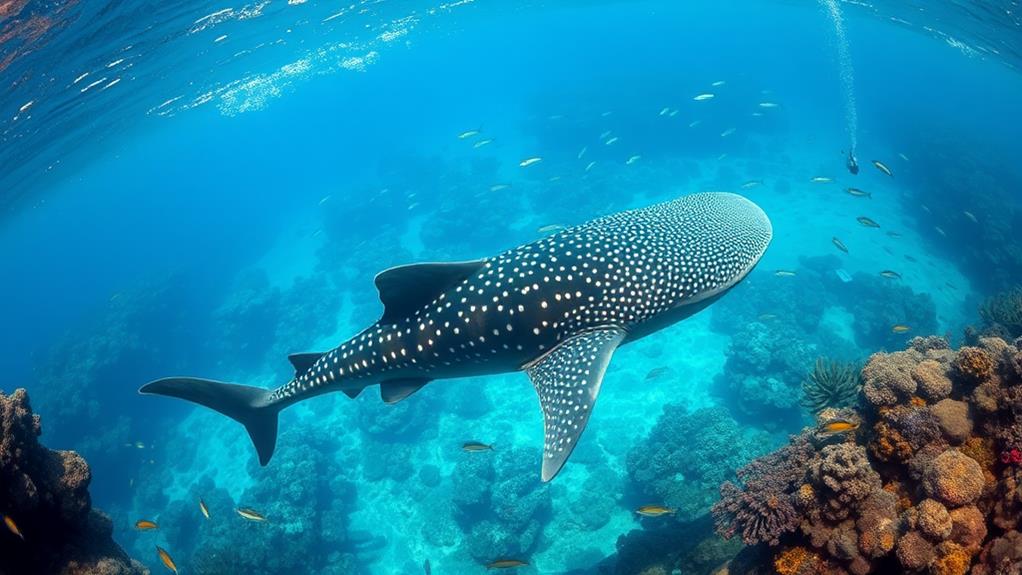
Whale sharks are the largest fish species, typically measuring between 18 to 33 feet in length, with some individuals reaching over 40 feet.
Their large size is supported by their broad, flat heads and mouths, which can extend up to 5 feet wide, allowing them to efficiently filter water for food.
Whale sharks are filter feeders, and their diet consists mainly of plankton, small fish, and other tiny marine organisms.
This unique feeding adaptation is crucial for their survival.
Whale sharks inhabit warm, tropical waters around the globe, particularly in offshore areas and coastal upwelling zones.
Each whale shark has a unique pattern of light spots on a dark gray background, making individual identification possible.
Whale sharks play a vital role in marine ecosystems, and their presence indicates a healthy marine environment and a balanced ecosystem.
Their gentle nature and unique characteristics attract divers and marine enthusiasts, who can observe these magnificent animals in their natural habitat.
Physical Characteristics
Physical Characteristics of Whale Sharks
Whale sharks, the largest living fish, exhibit remarkable physical features that fascinate marine biologists. They can grow up to 61.7 feet (18.8 meters) in length, with the largest recorded specimen measuring this astonishing size. Their broad, flat heads host mouths that can reach up to 4 feet (1.2 meters) wide, perfectly adapted for their filter-feeding behavior.
Key Physical Features:
| Feature | Description |
|---|---|
| Length | Up to 61.7 feet (18.8 meters) |
| Mouth Width | Up to 4 feet (1.2 meters) |
| Skin Thickness | Up to 4 inches (10 cm), with unique spotting patterns |
At birth, whale sharks measure between 21 to 25 inches (53 to 64 cm). Their skin features distinct patterns of light spots on a dark gray background, along with a white underside, allowing for individual identification. Specialized velums in their mouths prevent food loss while filtering vast amounts of water. These adaptations highlight not only their massive size but also their unique evolutionary traits in the marine ecosystem.
Diet and Feeding Habits

Whale sharks are highly efficient filter feeders due to their specialized feeding strategies and physical characteristics. They primarily consume zooplankton, fish eggs, krill, jellies, and small fish, using their enormous mouths to filter large volumes of water.
Their throat size restricts swallowing to small particles, roughly the size of a quarter, allowing them to efficiently capture tiny organisms.
Whale sharks employ cross-flow filtration, concentrating food particles while expelling excess water, which enhances their feeding efficiency. They can consume up to 8% of their body weight in food each week, underscoring their substantial dietary needs.
Their feeding behaviors include active surface suction and vertical suction feeding, with the top jaw often breaking the water's surface during the process. This method not only facilitates the intake of nutrients but also showcases their unique adaptations for thriving in diverse marine environments.
Habitat and Range
Whale Sharks Inhabit Tropical Waters Across the Globe
Whale sharks thrive in tropical waters across the Atlantic, Pacific, and Indian Oceans, typically found between 30° N and 35° S latitude. These habitats often include shallow waters near bays and coastal upwelling areas, particularly during plankton blooms, which attract the largest fish to feed.
Preferred Habitats
Whale sharks frequent three main habitat types:
| Habitat Type | Description |
|---|---|
| Coastal Upwelling | Nutrient-rich areas that attract prey |
| Coral Atolls | Diverse ecosystems providing shelter |
| Lagoons | Shallow, protected waters for feeding |
Adaptability and Migration Patterns
Whale sharks exhibit remarkable adaptability, displaying seasonal migration patterns based on food availability. While they primarily inhabit offshore environments, sightings have been reported as far north as 41° N and as far south as 36.5° S, highlighting their extensive geographical range in warm waters.
Conservation Implications
Understanding these patterns is crucial for conservation efforts, as their habitats are increasingly threatened by human activities. Whale sharks' versatility in habitat selection allows them to thrive in various marine environments, ensuring their survival as the largest fish in the ocean.
Reproduction and Growth
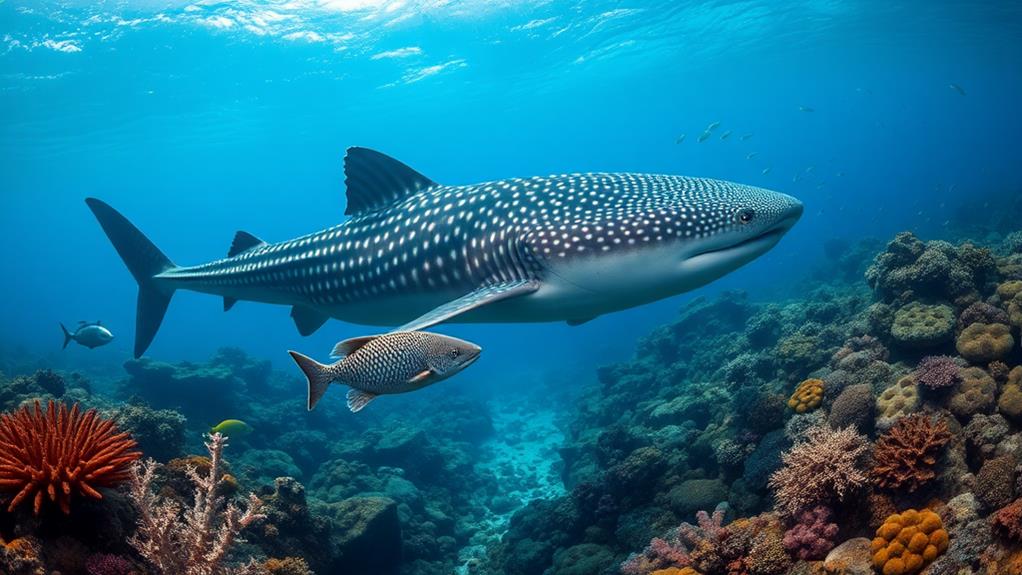
Whale sharks have a unique reproductive strategy that affects their population dynamics. They're ovoviviparous, meaning their embryos develop in eggs that hatch inside the uterus, resulting in the birth of fully formed pups. This method of reproduction allows a single whale shark to give birth to a litter size exceeding 300 pups, highlighting their potential for rapid population growth.
Understanding whale shark mating behavior is crucial, but it remains poorly understood. Only two natural mating observations have been documented, emphasizing the need for further research on their reproductive habits and growth rates.
Environmental factors, such as water temperature, food availability, and habitat quality, play a critical role in whale shark population growth by directly impacting their reproductive success.
Effective conservation strategies rely on understanding whale shark reproduction. Recognizing the challenges and potential of whale shark reproduction emphasizes the importance of preserving their habitats and ensuring a sustainable future for these magnificent creatures.
Conservation Status
Whale Sharks are Endangered
The conservation status of whale sharks is critical, as they're classified as endangered by the International Union for Conservation of Nature (IUCN). This downgrade from vulnerable to endangered in 2016 highlights the urgent need to address the threats facing this species.
Fishing net entanglement, boat strikes, and the ingestion of marine debris are major threats that severely impact their survival.
Regulatory Frameworks
Regulatory frameworks like Appendix II of CITES and the Convention on Migratory Species (CMS) aim to facilitate the conservation and management of whale sharks.
However, unregulated tourism poses additional risks, leading to habitat degradation.
Conservation Initiatives
Establishing marine protected areas plays a vital role in safeguarding whale shark populations.
These areas not only help ensure their habitats remain intact but also promote awareness of their ecological importance.
Swimming Experience
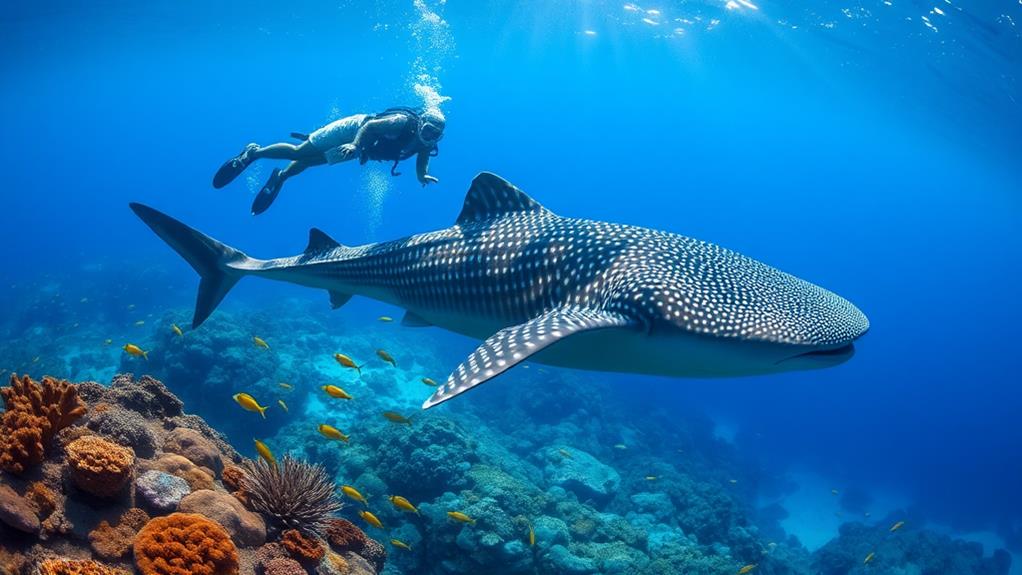
Swimming with Whale Sharks: A Unique Oceanic Experience
Swimming alongside whale sharks offers a unique opportunity to engage with one of the ocean's largest and most gentle inhabitants.
This experience typically takes place in warm tropical waters, such as La Paz, Mexico, where encounters peak from October to February.
Safety Regulations
To ensure a safe and respectful experience, swimmers must wear life jackets, masks, snorkels, and fins and adhere to strict distance guidelines: keeping at least three feet from the body and ten feet from the tail of the whale shark.
Additionally, a maximum of five swimmers are permitted in the water with one guide at a time to minimize disturbances to these majestic creatures.
Guided Tours
Guided tours, which operate on a first-come, first-served basis, recommend tour times at 9 am, 12 pm, and 3 pm for optimal encounters.
These tours allow for a mesmerizing experience, connecting you with nature while witnessing the whale sharks' grace and size up close.
Conservation and Appreciation
Engaging in swimming with whale sharks deepens your appreciation for oceanic wildlife and conservation efforts.
This unforgettable experience fosters a deeper connection with nature, encouraging responsible tourism practices to protect these incredible creatures and their habitats.
Safety Guidelines
Safety Guidelines for Swimming with Whale Sharks
When swimming with whale sharks, it's crucial to follow safety guidelines to ensure both your well-being and the animals' protection.
Maintaining a Respectful Distance
Stay at least three feet away from the body and ten feet away from the tail to minimize stress on these magnificent creatures. This respectful distance helps prevent disrupting their natural behavior.
Snorkeling and Scuba Diving
Only snorkeling is permitted during whale shark encounters. Scuba diving is strictly prohibited to reduce disturbances to the species and their habitat.
Riding and Stress
Avoid riding on whale sharks, as this can cause undue stress and negatively affect their natural behavior. Remember, whale sharks are wild animals that deserve respect and care.
Local Regulations and Conservation
Follow local regulations to support conservation efforts. For example, refrain from using flash photography, which can startle the sharks and disrupt their environment.
Prime Locations for Encounters
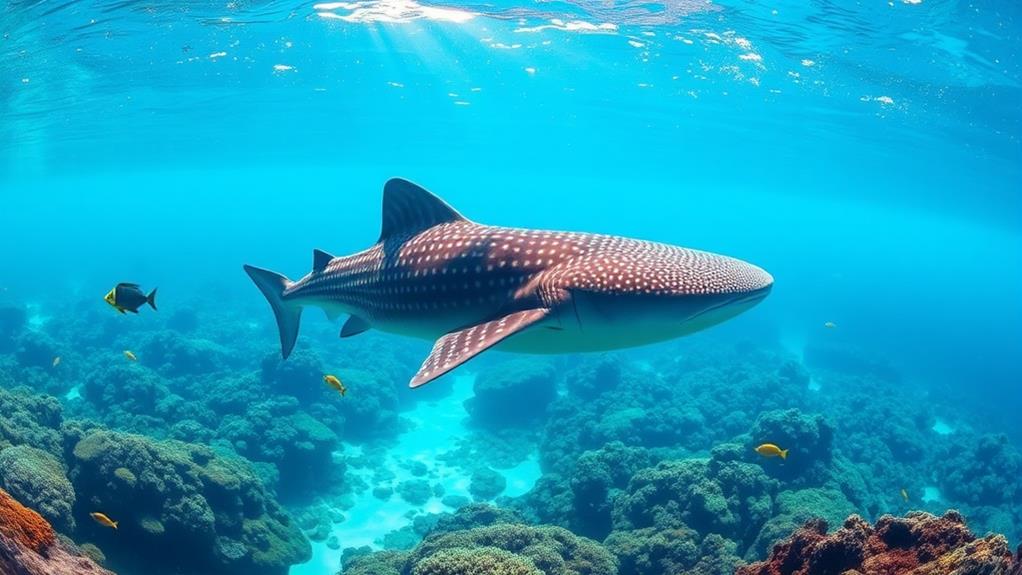
Prime Locations for Whale Shark Encounters
Whale sharks can be found in specific locations around the world, with peak seasons that increase the chances of encounters.
Mexico's Cancun and Isla Holbox are top spots, with peak encounters from June to September.
Another prime location is Belize, particularly at Gladden Spit and Silk Cayes Marine Reserve, where whale sharks gather during the April and May spawning events.
Honduras' Utila Island is also a hotspot, with high concentrations of whale sharks from March to April.
In Australia, Ningaloo Reef provides excellent opportunities from mid-March to July.
Other prime locations for whale shark sightings include the Philippines, Seychelles, Galapagos, Mozambique, and the Maldives, each with unique seasonal peaks.
Understanding these prime locations and their respective seasons is crucial for maximizing the chances of a memorable encounter with the largest fish in the world.
Booking Your Trip
Booking a trip to swim with whale sharks requires careful planning to ensure a successful encounter.
The best time to book your tour is between October and February, when whale sharks are most active in La Paz, Mexico. To find accommodation close to tour operators, use platforms like Booking.com, Hotels.com, and Expedia.
Guided tours operate on a first-come, first-served basis, so early booking is highly recommended to secure your spot.
Only 14 licensed boats are permitted in the designated 10-kilometer area, ensuring a sustainable and controlled environment for whale shark encounters.
Tour times are available at 9 am, 12 pm, and 3 pm, providing flexibility in scheduling your swim with whale sharks.
Consider your itinerary and personal preferences when selecting a time to ensure a memorable and impactful experience with these magnificent creatures.
Health Benefits of Swimming
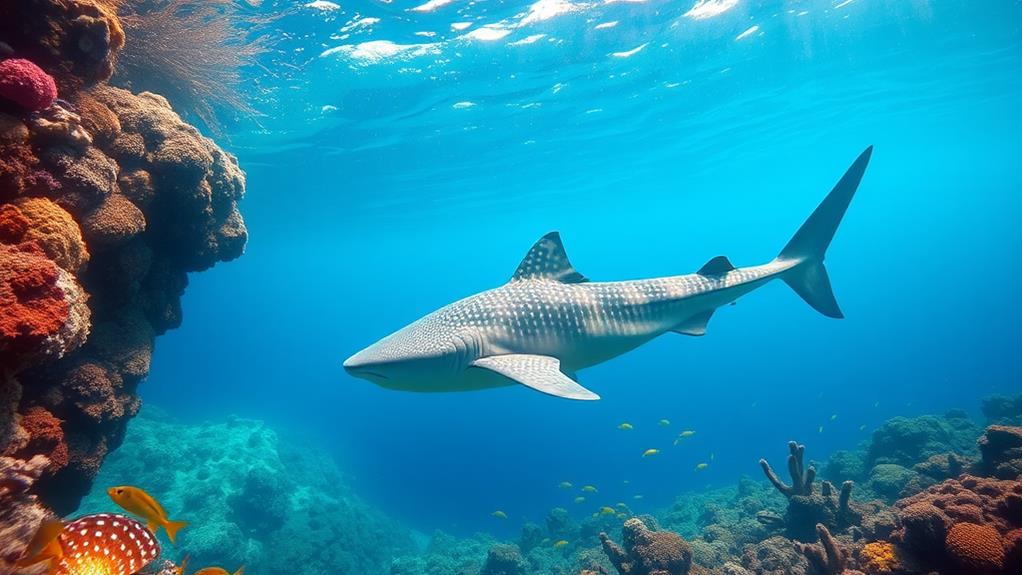
Swimming with whale sharks offers numerous health benefits. Engaging in this activity improves overall well-being in three significant ways:
Cardiovascular and Muscle Strength: Swimming with whale sharks provides low-impact exercise suitable for all fitness levels. This exercise enhances cardiovascular health by strengthening the heart and increasing blood flow.
Additionally, it builds muscle strength without straining the body, making it an ideal activity for people with joint issues or chronic pain.
Mental Well-Being: Interacting with whale sharks in their natural habitat fosters mental clarity and reduces stress levels. The calming marine environment promotes relaxation, reducing anxiety and depression.
This unique experience can significantly improve mood and overall mental well-being.
Social Interaction: Participating in guided whale shark tours allows individuals to connect with like-minded people, promoting social health.
Sharing this experience with others encourages positive interactions, builds relationships, and creates lasting memories.
Cultural Significance and Folklore
Whale Sharks Hold Significant Cultural Value
Whale sharks are deeply rooted in the cultural heritage of many communities, symbolizing good luck, prosperity, and respect for nature. In various cultures, they are depicted as gentle giants, reflecting their importance in the marine ecosystem and human connection to the sea.
Local Art and Literature Celebrate Whale Sharks
Local art and literature frequently feature whale sharks, highlighting their significance in the marine ecosystem and human connection to the sea. For example, in some coastal towns, whale shark-inspired murals adorn buildings, while local stories and poems often portray them as gentle creatures.
Cultural Festivals Foster Community Engagement
Cultural festivals centered around whale shark sightings promote community engagement and raise conservation awareness. These festivals bring people together, encouraging local traditions and strengthening local identity. For instance, in some communities, whale shark festivals feature traditional music, dance, and food, while also providing educational workshops on whale shark conservation.
Symbolism and Impact
Whale sharks hold significant symbolic value, with various implications:
| Symbolism | Impact |
|---|---|
| Good Luck | Encourages local traditions |
| Conservation Awareness | Promotes sustainable practices |
| Community Engagement | Strengthens local identity |
| Respect for Nature | Fosters harmony with the ocean |
| Economic Support | Sustains livelihoods |
These symbols not only reflect the cultural significance of whale sharks but also have a direct impact on the community, promoting conservation, respect, and economic growth.
Questions and Answers
Is the Whale Shark the Largest Fish in the World?
The whale shark is indeed the largest fish in the world.
It can grow over 40 feet long, with some specimens exceeding 61 feet in length.
This enormous size allows it to filter feed effectively, which is facilitated by its massive mouth that can reach 5 feet wide.
Understanding these dimensions helps appreciate the sheer scale of this magnificent marine creature.
Which Is the Biggest Fish in the World?
The whale shark is the biggest fish in the world, measuring over 40 feet long and weighing up to 20 tons.
This massive fish has a unique way of eating: it feeds on plankton, small fish, and krill by filter feeding.
This method allows it to survive in different ocean environments.
How Much Does It Cost to Swim With Whale Sharks in La Paz?
The cost of swimming with whale sharks in La Paz ranges from $100 to $200 per person. This price is influenced by the tour operator and package details.
Most tours include essential gear and refreshments, but it's essential to verify what's included to avoid any surprises.
Booking in advance is recommended, especially during peak season, as spots fill up quickly.
Optional services like transportation and photography can increase your overall cost, so consider these factors carefully when planning your trip.
What Is the Biggest Fish to Ever Swim in the Ocean?
The biggest fish to ever swim in the ocean is the whale shark, which can reach lengths up to 61.7 feet.
Although the average size of a whale shark ranges from 18 to 32 feet, some individuals can grow much larger.
These massive creatures can weigh as much as 20 tons, making them significantly larger than any other fish species.
Their enormous size, combined with their gentle nature, makes them remarkable creatures that play a vital role in the ocean ecosystem.